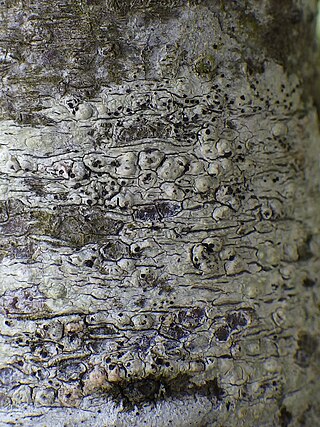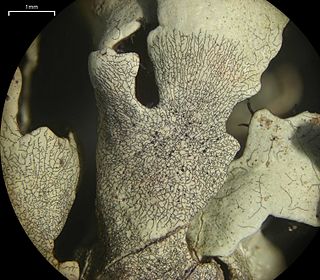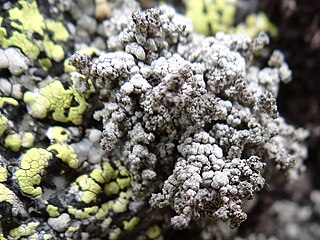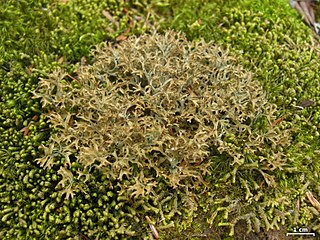Endococcus is a genus of lichenicolous (lichen-dwelling) in the family Lichenotheliaceae. It has 44 species. The genus was circumscribed by the Finnish botanist William Nylander in 1855. Although at least one source places the genus in the Verrucariaceae, a 2016 study of the type species, Endococcus rugulosus, determined that it should instead be placed in the family Lichenotheliaceae of the order Dothideales; this classification echoes a placement proposed in 1979 by David Hawksworth.

Skyttea is a genus of lichenicolous (lichen-dwelling) fungi in the family Cordieritidaceae. The genus was circumscribed in 1981 by lichenologists Martha Allen Sherwood, David L. Hawksworth, and Brian J. Coppins, with Skyttea nitschkei assigned as the type species.

Lichenostigma cosmopolites is a species of lichenicolous fungus belonging to the family Phaeococcomycetaceae. It was described as new to science in 1999 by lichenologists Josef Hafellner and Vicent Calatayud. The fungus grows parasitically on Xanthoparmelia lichens. In India it has been reported from the thallus of Xanthoparmelia stenophylla.

Cordieritidaceae is a family of fungi in the order Cyttariales. Species in this family are saprobes or lichenicolous.
Lichenopeltella uncialicola is a species of fungus belonging to the class Dothideomycetes. The species was discovered in Iceland in 2010 where it was found growing on Cladonia uncialis. Since then, it has been found on a different host species, Cladonia rangiferina, in North-Korea, Italy Austria, and Greenland.
Xenonectriella subimperspicua is a species of lichenicolous fungus in the family Nectriaceae. It has been recorded from South America, Europe, and New Zealand.
Nanostictis caucasica is a species of lichenicolous (lichen-eating) fungus in the family Stictidaceae. It is known to occur only in a single locality in the North Caucasus region of Southern Russia, where it grows parasitically on the foliose lichen Parmelia sulcata.
Clypeococcum bisporum is a species of lichenicolous (lichen-eating) fungus in the family Polycoccaceae. It is found in the Russian Far East, in Mongolia, and from northwest Alaska, where it grows parasitically on lichens from the genera Cetraria and Flavocetraria.
Neoechinodiscus kozhevnikovii is a species of lichenicolous (lichen-eating) fungus in the order Helotiales. It is known to occur in Russia, Austria, and Switzerland, where it grows parasitically on lichens in genus Cetraria.
Endococcus hafellneri is a species of lichenicolous (lichen-eating) fungus in the family Verrucariaceae. It is found in North Asia and the Russian Far East, Estonia, and Japan, where it grows on the lobes of the lichens Flavocetraria cucullata and Cetraria islandica.
Opegrapha verseghyklarae is a little-known species of lichenicolous (lichen-eating) fungus in the family Teloschistaceae. It is found in the Russian Far East, where it grows on the thalli and apothecia of the crustose lichen Ochrolechia pallescens.

Stereocaulon vesuvianum is a species of snow lichen belonging to the family Stereocaulaceae.

Stereocaulon tomentosum is a species of snow lichen belonging to the family Stereocaulaceae.

Stereocaulon saxatile is a species of snow lichen belonging to the family Stereocaulaceae.
Sphaerellothecium araneosum is a species of lichenicolous fungus in the family Phyllachoraceae.
Polycoccum laursenii is a species of lichenicolous fungus in the family Polycoccaceae. It was first described as a new species in 2004 by Russian mycologist Mikhail Petrovich Zhurbenko. It is found in Alaska and in Russia.
Endococcus nanellus is a species of lichenicolous fungus in the order Dothideales. It is known from Alaska, Canada, Greenland, Hawaii, Japan, Russia, South-Korea, and Kazakhstan.
Phacopsis oroarcticae is a species of lichenicolous (lichen-dwelling) fungus in the family Parmeliaceae. It was formally described as a new species in 2010 by Russian mycologist Mikhail P. Zhurbenko. The type specimen was collected from a stony polar desert in the Severnaya Zemlya Archipelago in Central Siberia, where it was found growing on the lobes of the foliose lichen Brodoa oroarctica; the species epithet refers to its host. Infection by the fungus results in bleached, swollen, and sometimes contorted lobes. It is the first Phacopsis species known to have Brodoa as a host.
Phacopsis vulpicidae is a species of lichenicolous (lichen-dwelling) fungus in the family Parmeliaceae. It was formally described as a new species in 2019 by mycologists Mikhail P. Zhurbenko and Paul Diederich. The type specimen was collected by the first author near the headwaters of Ar Khordolyn gol River in Renchinlkhümbe Somon, at an altitude of 2,050 m (6,730 ft). There, in the upper limit of a Larix sibirica forest, the fungus was found growing on the thallus of a ground-dwelling Vulpicida juniperina lichen. The species epithet vulpicidae refers to the genus of its host. Infections by the fungus cause blister-like (bullate) swellings of the host thallus. It is known to occur in arctic and mountain tundra and taiga biomes of Asia, Europe, and North America (Alaska). Its only recorded host is Vulpicida juniperina, and almost all recorded host specimens have been terricolous.

Cetraria laevigata is a species of ground-dwelling, fruticose (bushy) lichen in the family Parmeliaceae. It was formally described as a new species by Russian lichenologist Kseniya Aleksandrovna Rassadina in 1943. In North America, it is commonly known as the striped Iceland lichen.






